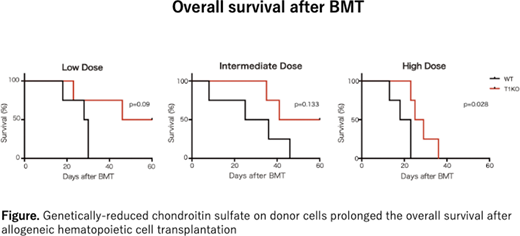Introduction: Severe acute graft versus host disease (GVHD) represents a major risk associated with allogeneic hematopoietic cell transplantation (HSCT). Both acute and progressive GVHD following HSCT are in large part attributable to responses of donor T cells to host allo-antigens. Alloreactive T cell activation can be modulated by signals from the tissue microenvironment (TME). Glycosaminoglycans (GAGs) in the TME or modifying T cell surface proteoglycans are known to regulate T cell function. However, the roles of GAGs in acute GVHD following allogeneic HSCT remain to be elucidated, since a suitable murine model has not been available. We previously established a unique mouse model (T1KO), in which knockout of the chondroitin sulfate (CS) N-acetylgalactosaminyltransferase-1 (T1) gene - encoding the rate-limiting CS-synthesizing enzyme - decreases CS production. We also reported a role for CS in murine hematopoietic stem cells. In the present study, we focus on donor T cell CS levels to assess the role of T cell CS in acute GVHD following allogeneic HSCT. We were able to mitigate the clinical features of GVHD in a murine model using T1KO donors.
Methods: Eight- to 12-week-old T1KO mice were generated from a C57BL/6N (WT) strain as donors (H-2b) for allogeneic bone marrow transplantation (BMT). Donor BM cells were then transplanted into eight- to 12-week-old BALB/c recipients (H-2d). Prior to transplantation, recipients were irradiated at a dose of 7 Gy. They then received 5 x 106 BM cells and splenocytes of identical genotype, as well as low (5 x 105), intermediate (1 x 106), or high (4 x 106) doses of CD90.2+ cells from either WT or T1KO donors. For five weeks following BMT, survival was monitored daily and clinical GVHD scores (incorporating body weight, activity, fur condition, alopecia, and tortoiseshell-like mucosae) were calculated three times per week.
Results: The peripheral blood CD4+/CD8+ T cell ratio of T1KO mice was equivalent to that of WT mice. Following allogeneic BMT, histopathologic analysis confirmed onset of acute recipient GVHD on day 49 when donors were WT mice. As a result, significant lymphocyte infiltration was observed in target organs (liver, colon, and skin). High-dose transplantation of splenocytes from T1KO rather than WT mice significantly prolonged recipient median survival (27.0 versus 20.5 days, p = 0.02). A similar trend was observed for low- and intermediate-dose transplantation (low: 53.0 versus 29.0 days, p = 0.09; intermediate: 50.5 versus 30.5 days, p = 0.13. Similarly, a significant improvement in day 11 GVHD score was observed following high-dose splenocyte transplantation when donors were T1KO mice (mean scores: 1.00 versus 2.75, p < 0.01). However, no significant differences in GVHD score were observed following low- and intermediate-dose transplantation. Taken together, our results suggest that donor T cells producing lower CS levels alleviate acute GVHD following allogeneic HSCT in a murine model.
Conclusion: Alloreactive T cell activation following allogeneic HSCT may be down-regulated by lower CS levels, thereby mitigating GVHD severity.
No relevant conflicts of interest to declare.
Author notes
Asterisk with author names denotes non-ASH members.


This feature is available to Subscribers Only
Sign In or Create an Account Close Modal